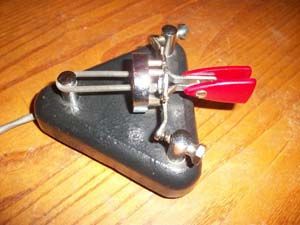Today's post-holiday mail brought with it a tightly packed bundle of iambic key history — an original HAL FYO iambic key.

The key was designed by Joseph Hills, W8FYO, of Dayton, Ohio. He built his version of the key, first a single non-iambic style and then a two-lever iambic key — from 1962-3 time frame. He received a patent in 1965, but didn't mass produce his keys. The design was later licensed by HAL Communications Corp and they produced the key for two years — 1975 and 1976 — before they sold their inventory, rights and tooling to Hamco.
Hamco produced the key for a handful of years as the Scotia, Carson and Trinidad, with a base of wood and brass that was either finished with an engine-turned finish (Trinidad), polished (Carson) or satin (Scotia). Scotia made a significant upgrade to the original design by moving from springs to magnetic tensioning. Vibroplex bought Hamco and the paddle was rechristened “Brass Racer.” The Brass Racer and the Hamco Scotia model are nearly identical, save for one feature: All the Hamco-produced keys have holes in the top of the pivot frame for hex-key set screws that secure the tensioning magnets in place. Vibroplex eliminated the set screws, and the tensioning magnets are essentially press fit in place. While this sounds like a rinky-dink way to do it compared to having set screws, it has worked well for Vibroplex for the years the key has been in production.
I don't know why, but I seldom consider the Brass Racer to be a direct descendant of the FYO key. I've never liked the looks of the wood-and-brass base of the Scotia/Brass Racer.
Anyway, back to my new arrival, the HAL FYO.
The key has considerable heft; I think it weighs more than a Bencher. Comparing the Bencher versus the HAL FYO, there are some differences.
1. On the HAL, each half of the metal 90-degree paddle mechanism is one piece of metal. On the Bencher, each half is made of two parts — the half-circle part that houses the pivot points, and the thinner metal bracket that holds both the paddle and the key contact.
2. The Bencher has nylon inserts for the pins where each half of the paddle “rocks.” On the HAL, it is metal on metal, with very small holes and pins used to hold the paddle level in place (the Brass Racer is true to the HAL design as well).
3. The Bencher paddles are larger triangle shapes than the HAL. The HAL paddles resemble those found on the Brass Racer, but are indeed smaller. The difference is noticeable when operating the key, you have to hold your hand more upright.
The HAL has a very light touch, but the mechanism seems more solid and less likely to come apart compared to some who complain about the Bencher falling apart on them in mid-QSO.
My keying is very, very rusty at speeds over 15 wpm with an iambic key; I'm certainly QLF at these speeds using the HAL, hi hi!
The lever action seems like a smaller mechanism than the Bencher, though I haven't really measured it to confirm that observation.
My HAL has the serial number scratched in the base as no. 487. The guy I bought it from also recently sold an even earlier HAL FYO that I was watching closely. That one sold for nearly $160, which was well beyond what I was willing to spend on a key that you don't see often for sale. The week after that one sold (I was outbid in the last 3 seconds!), the seller listed the one pictured. I decided to watch it as well. On the second one, I got lucky — I sniped it in the last couple of seconds at a price well below half of what the first HAL key brought. I'm sure there were half a dozen bidders with higher bids ready to go, but I was lucky enough to get my bid submitted in the last 2 seconds; I'm sure I would have been outbid had I submitted a bid 2 or 3 seconds earlier!
—
One of the first issues I had with the key wasn't really with the key, but with my rig; I normally operate a bug or on rare occasion, a straight key, so I had to re-remember how to turn on the keyer and set it up (the FT-2000 has different settings for the front and rear key jacks). I keep the manual handy, but fortunately I didn't need it, hi!
Keying with the keyer felt pretty odd; I'm so out of sorts with keyer operation (though I expect I send better CW that way). I'm not sure I could operate the HAL with its original paddles; I'm still going to play with it a while, might be worth a try. It's an interesting addition to my collection, and its in pristine shape for a key that's 30-plus years old.
That's enough this time … g'nite and 73 … de KY4Z .. SK dit dit
